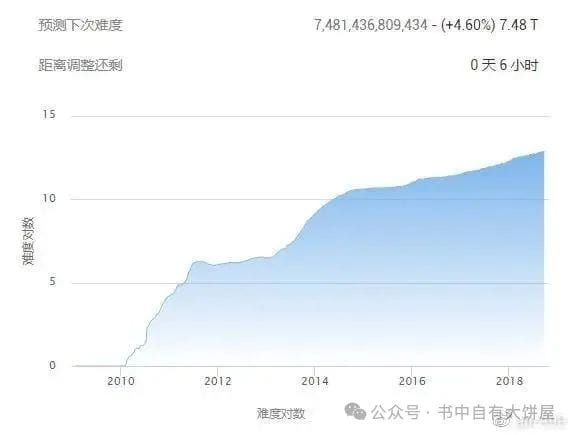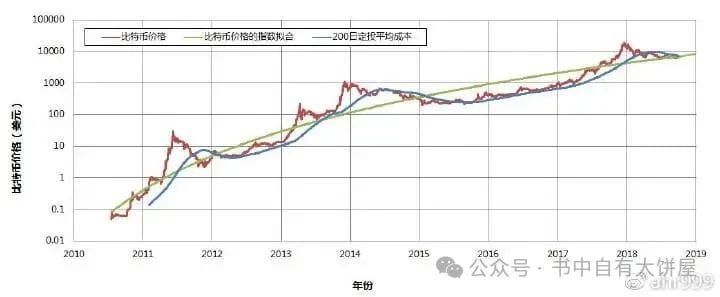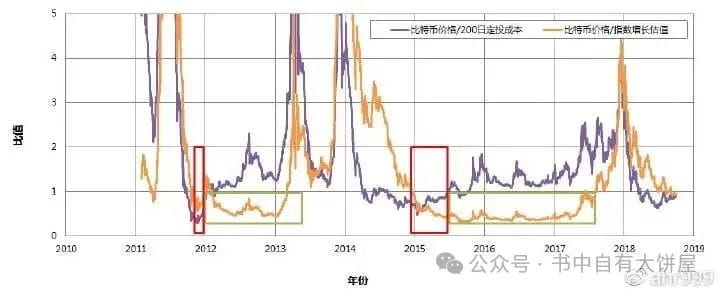We all hope to obtain more Bitcoin with limited investment, so when is the right buying point?
Many Bitcoin fanatics will tell you that you can buy Bitcoin at any time. This statement is both correct and incorrect.
It is correct because, on a large time scale, buying Bitcoin at any time can yield huge returns. For example, the peak of the last bull market was 8,000 yuan; perhaps it really trapped a batch of people, but as long as they held on until today, it is still a multiple return.
It is incorrect because every holder has a limited amount of funds. This means that if you manage well, you can obtain several times more coins. For example, if you reduce your average cost to 2,000 yuan through dollar-cost averaging, then your coin amount will be four times that of buying at the peak. Based on our previous calculations, you can achieve financial freedom one cycle (4 years) earlier, which is obviously very important.
I hope all holders can hold coins at the lowest cost. Why? Holders are the strong hands in the market, buying without selling. I certainly hope that more coins are concentrated in the hands of the strong hands rather than those who trade back and forth, as they will eventually have to sell them anyway.
So, the question arises, how do we determine the timing for purchase?
Li Xiaolai proposed in (A Brief Survival Guide in the World of Bitcoin):
In the long run, I believe we can consider miner costs as fundamentals.
However, he never explained the reasons, so many people do not agree with his viewpoint.
I believe this statement makes sense. The lowest price in the previous bear market was 900 yuan, and at that time, Wu Jihan revealed in an interview that the marginal cost of producing a coin was 800 yuan. This indirectly supports Li Xiaolai's viewpoint.
Let's first look at the difficulty growth of Bitcoin (Figure 1). Although Bitcoin prices fluctuate greatly, the difficulty has hardly ever retraced, instead showing a one-way increase.

Figure 1. The growth of Bitcoin mining difficulty (data source: btc.com)
This indicates that Bitcoin prices have never fallen below the electricity cost of mainstream mining machines at that time; otherwise, there would be a large-scale shutdown, and the hash rate would decline, leading to a decrease in mining difficulty. Therefore, the electricity cost is a hard support for Bitcoin prices, a viewpoint that has at least been valid in history.
However, this phenomenon is economically unreasonable because prices are determined by demand and are unrelated to costs. When theory conflicts with fact, we need to revise the theory; below is my personal explanation.
The special thing about Bitcoin is that anyone, including you and me, when preparing to hold Bitcoin, will consider its production cost. **Because everyone has two ways to obtain Bitcoin: buying coins and mining. If you can obtain Bitcoin through mining at a cost of $5,000, you wouldn't buy it for $6,000.
At this point, Bitcoin is fundamentally different from other goods. If you want to buy an iPhone or wine, you mainly care about the quality of the product, not the cost. However, if you want to purchase Bitcoin, your main concern is the cost.
Costs vary from person to person. Each person's cost is different. If I go mining, my cost might be $10,000, so for me, buying directly is certainly more cost-effective.
However, there will always be people who control mining machines or power resources. The larger the funds, the more motivation and resources they have to combine for low costs. Once Bitcoin prices approach the minimum cost line, funds originally intended for mining will no longer be invested but will choose to buy coins. This explains why Bitcoin prices have never fallen below the electricity cost of mainstream mining machines.
Based on this phenomenon, we can make the judgment that the lower limit of Bitcoin prices is the electricity cost of current mainstream mining machines.
However, even knowing this, there is still not much operability. What if this bear market does not drop to the cost line? After all, it is an opportunity that is hard to come by for it to drop to 900 yuan like the last round.
Therefore, we must first buy some Bitcoin at relatively low prices, then keep some money or earn more, waiting for opportunities that are hard to come by.
What do we mean by relatively low positions? Let's take another look at the historical prices of Bitcoin (Figure 2).

Figure 2. Historical Bitcoin prices and the 200-day dollar-cost averaging average cost.
The red line is the price of Bitcoin, which conforms to the index growth model, while the green line is the fitted line of Bitcoin price index growth. Theoretically, as long as you buy Bitcoin when the price (red line) is below the fitted line (green line), it is cost-effective.
The blue line represents the 200-day dollar-cost averaging cost; note that it differs from the 200-day average price. The 200-day average price is the arithmetic mean, while the 200-day dollar-cost averaging cost is the geometric mean. Please search for the difference between the two; the geometric mean is always less than the arithmetic mean.
Imagine a person who started dollar-cost averaging Bitcoin 200 days ago, investing a fixed amount of 1 yuan every day. By continuing to dollar-cost average until today, his average cost would be represented by the blue line.
Many people advocate for dollar-cost averaging in Bitcoin, which makes a lot of sense. Because the dollar-cost averaging cost (blue line) runs below the coin price (red line) for most of the time. That is to say, if you stick to dollar-cost averaging, you can outperform most one-time buyers of coins.
So, in which specific range is it most cost-effective to buy Bitcoin? It must meet two conditions:
· Bitcoin prices below the 200-day dollar-cost averaging average cost mean that at this time, buying coins can outperform those who dollar-cost average.
· Bitcoin prices below the index growth model valuation mean that at this time, the coin price is undervalued.
Figure 2 is in exponential coordinates and is not clear. **We now define two ratios: Bitcoin price/200-day dollar-cost averaging cost and Bitcoin price/index growth valuation. **When both of these ratios are simultaneously below 1, it indicates that Bitcoin prices are undervalued, and directly purchasing Bitcoin is more cost-effective than long-term dollar-cost averaging.
Let's look at the historical trends of these two ratios (Figure 3).

Figure 3. Bitcoin price/200-day dollar-cost averaging cost and Bitcoin price/index growth valuation.
Historically, there have been two instances where both ratios were below 1 simultaneously. One occurred at the end of 2011, lasting for two months; the other was in the first half of 2015. These are indicated in red boxes in Figure 3.
After these two time periods, there has been a long time (over 1 year) where Bitcoin price/200-day dollar-cost averaging cost > 1, but Bitcoin price/index growth valuation < 1. This means that the coin price is still undervalued, but directly buying coins is slightly inferior to dollar-cost averaging, though the difference is not significant. This is indicated with green boxes in Figure 3.
Whether it is the red box or the following green box, both are very good times to buy Bitcoin. The time window is actually quite long, and there is no need to rush, fearing that you will miss something.
So, where are we now? Today, both ratios have just crossed into the range below 1; in other words, we may be welcoming the third-best opportunity to accumulate Bitcoin in history.
Considering that Bitcoin will halve its output in one and a half years, the time window for the third-best accumulation opportunity may be about a year. **Ultimately, how much Bitcoin can be accumulated depends largely on our past savings and our ability to earn money in the next year.
Compared to the previous bear market, there was still a halving of Bitcoin prices in this range. **But in any case, conducting dollar-cost averaging in this range will not have a cost much higher than buying at the lowest point.
In summary, in the long run, we can consider miner costs as fundamentals. For most of the time, dollar-cost averaging is an excellent strategy. When the Bitcoin price is simultaneously below the 200-day dollar-cost averaging cost and the index growth valuation, it indicates that Bitcoin is undervalued, and directly purchasing Bitcoin is more cost-effective than long-term dollar-cost averaging. We have just entered a range where both ratios are less than 1; we may be welcoming the third-best opportunity to accumulate Bitcoin in history, with a time window of about a year.
Li Xiaolai mentioned in (The Self-Cultivation of Leeks):
All-in is a taboo for traders; you must always keep a certain percentage of cash.
I completely agree and do not recommend anyone to go all-in on Bitcoin. If you really plan to accumulate Bitcoin, it is not advisable to exceed 30% of your funds. We will revisit this issue repeatedly later. From various perspectives, going all-in is not worth it.
(Accumulating Bitcoin) will share my thoughts and experiences during the process of accumulating Bitcoin over the past few years. The purpose of writing it is not to promote Bitcoin but to help those who are already prepared to accumulate Bitcoin. If you do not look favorably on Bitcoin, it is best to unfollow me. Whether one views Bitcoin favorably is largely related to personal values, and I have no intention of changing anyone's values.


